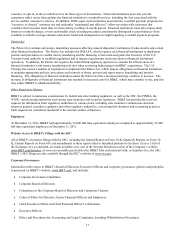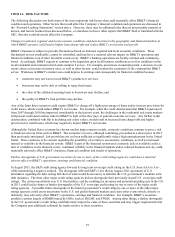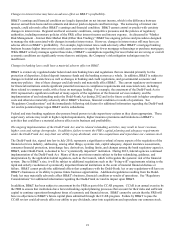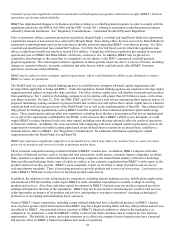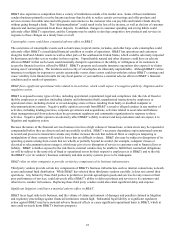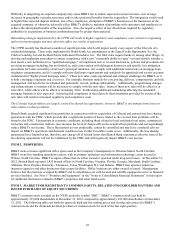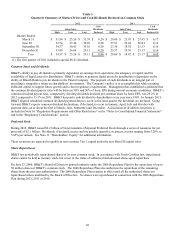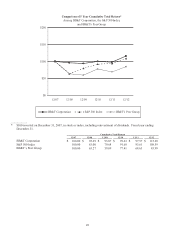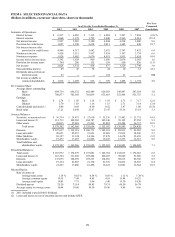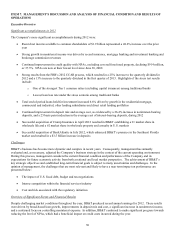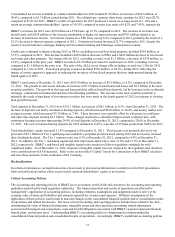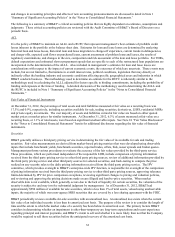BB&T 2012 Annual Report Download - page 46
Download and view the complete annual report
Please find page 46 of the 2012 BB&T annual report below. You can navigate through the pages in the report by either clicking on the pages listed below, or by using the keyword search tool below to find specific information within the annual report.24
BB&T faces systems failure risks as well as cyber-security risks, including “denial of service,” “hacking” and “identity
theft” that could adversely affect BB&T’s business and financial performance or reputation.
The computer systems and network infrastructure BB&T and its third-party service providers use could be vulnerable to
unforeseen problems. BB&T’ s operations are dependent upon its ability to protect computer equipment against damage from
fire, power loss or telecommunication failure. Any damage or failure that causes an interruption in BB&T’ s operations could
adversely affect its business and financial results.
In addition, BB&T’ s computer systems and network infrastructure are subject to security risks, and could be susceptible to
cyber-attacks, such as denial of service attacks, hacking, terrorist activities or identity theft. Denial of service attacks have
been launched against a number of large financial services institutions, including BB&T. None of these events resulted in a
breach of BB&T’ s client data or account information; however, the performance of BB&T’ s website, www.bbt.com, was
adversely affected and in some instances customers were prevented from accessing BB&T’ s website. We expect to be
subject to similar attacks in the future. While events to date primarily resulted in inconvenience, future cyber-attacks could
be more disruptive and damaging. Hacking and identity theft risks, in particular, could cause serious reputational harm.
Cyber threats are rapidly evolving and BB&T may not be able to anticipate or prevent all such attacks. BB&T may incur
increasing costs in an effort to minimize these risks and could be held liable for any security breach or loss.
Differences in interpretation of tax laws and regulations may adversely impact BB&T’s financial statements.
Local, state or federal tax authorities may interpret tax laws and regulations differently than BB&T and challenge tax
positions that BB&T has taken on its tax returns. This may result in differences in the treatment of revenues, deductions,
credits and/or differences in the timing of these items. The differences in treatment may result in payment of additional
taxes, interest or penalties that could have a material adverse effect on BB&T’ s results. For example, as discussed in Note 13
“Income Taxes” in the “Notes to Consolidated Financial Statements,” in February 2010, BB&T received an IRS statutory
notice of deficiency for tax years 2002-2007 asserting a liability for taxes, penalties and interest of approximately $892
million related to the disallowance of foreign tax credits and other deductions claimed by a subsidiary in connection with a
financing transaction. BB&T paid the disputed tax, penalties and interest in March 2010 and filed a lawsuit seeking a refund
in the U.S. Court of Federal Claims. The Court has scheduled the trial to begin March 4, 2013. Potential developments in
BB&T’ s litigation or in similar cases could adversely affect BB&T’ s financial position or results of operations.
BB&T may not be able to complete future acquisitions.
BB&T must generally satisfy a number of meaningful conditions before it can complete an acquisition of another bank or
BHC, including federal and/or state regulatory approvals. In determining whether to approve a proposed bank acquisition,
bank regulators will consider, among other factors, the effect of the acquisition on competition, financial condition and future
prospects, including current and projected capital ratios and levels, the competence, experience and integrity of management
and record of compliance with laws and regulations, the convenience and needs of the communities to be served, including
the acquiring institution’ s record of compliance under the CRA, the effectiveness of the acquiring institution in combating
money laundering activities and protests from various stakeholders of both BB&T and its acquisition partner. Also, under the
Dodd-Frank Act, U.S. regulators must now take systemic risk into account when evaluating whether to approve a potential
acquisition transaction involving a large financial institution like BB&T. BB&T cannot be certain when or if, or on what
terms and conditions, any required regulatory approvals will be granted. In specific cases, BB&T may be required to sell
banks or branches, or take other actions as a condition to receiving regulatory approval. An inability to satisfy other material
conditions necessary to consummate an acquisition transaction, such as third-party litigation, a judicial order blocking the
transaction or lack of shareholder approval, could also prevent BB&T from completing an announced acquisition.
BB&T may not be able to successfully integrate bank or nonbank mergers and acquisitions.
Difficulties may arise in the integration of the business and operations of BHCs, banks and other nonbank entities BB&T
acquires and, as a result, BB&T may not be able to achieve the cost savings and synergies that it expects will result from such
transactions. Achieving cost savings is dependent on consolidating certain operational and functional areas, eliminating
duplicative positions and terminating certain agreements for outside services. Additional operational savings are dependent
upon the integration of the acquired or merged entity’ s businesses with BB&T or one of BB&T’ s subsidiaries, the conversion
of core operating systems, data systems and products and the standardization of business practices. Complications or
difficulties in the conversion of core operating systems, data systems and products may result in the loss of customers,
damage to BB&T’ s reputation within the financial services industry, operational problems, one-time costs currently not
anticipated or reduced cost savings resulting from such mergers or acquisitions. Annual cost savings in each such transaction
may be materially less than anticipated if the holding company, bank merger or nonbank merger or acquisition is delayed
unexpectedly, the integration of operations is delayed beyond what is anticipated or the conversion to a single data system is
not accomplished on a timely basis.





